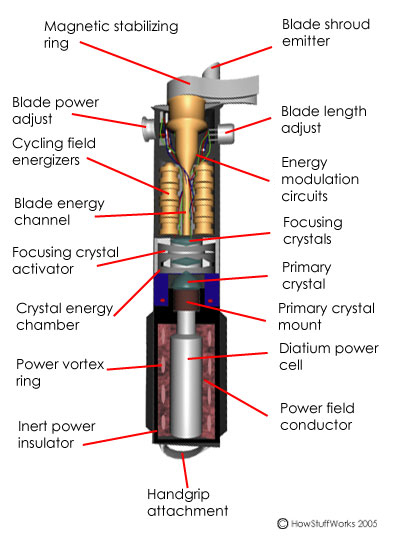The construction of one's lightsaber is an extremely important part of an apprentice's training in the Force. Not only does it show the technological mastery needed to construct what is a very intricate and complex instrument, but shows a strong attunement to the Force - one of the most integral tools used in the building of a lightsaber. The normal construction of a lightsaber takes about two months and requires constant attention on the part of the creator, as one slight imperfection could lead to the detonation of the entire weapon.
While all lightsabers are unique to their creators, there are a few items that are present in every individual weapon:
- A handgrip of some variety - The hilt of an average lightsaber is an alloy cylinder normally 25 to 30 centimeters long. Each hilt (or handgrip), however, is individual to the person who wielded it.
- An activation stud plate - Many lightsabers contains this component on the interior of the lightsaber as a safety feature; only its creator knows where it is exactly in the weapon, and they can use the Force to activate it.
- A safety switch - Normally part of the activation stud plate; when released, the blade would dissipate so that it wouldn't accidently slice someone. "Saber throws" are achieved by using the Force to hold down this switch.
- An emitter matrix - The series of lenses and energizers that hyper-focused the energy into the distinctive blade. If multiple crystals were used in the construction of the lightsaber, controls on the handgrip could alter the length, width, and power output of the blade.
- Power Assembly - see below
The principles behind the power source of a lightsaber are similar to those behind other hand-held weapons such as blasters; however, more attention is paid to aligning the energy along the axis of the lightsaber. The power assembly is made up of the following:
- Diatium power cell - Highly compact energy source; must provide very stable energy over a very long period. Similar to the power cells that are used to power small blasters.
- Power field conductor - Surrounds the power cell; causes the generated energy to be translated laterally, parallel to the the axis of the lightsaber.
- Power vortex ring - Surrounds the power field conductor; contains the generated energy so that virtually all of it can be used in the crystal energy chamber and, ultimately, result in a more powerful blade.
- Inert power insulator - Surrounds the power vortex ring and provides very high resistance against energy conductance to any potential external energy carriers. It works with the power vortex ring to maximize available energy.
- Energy gate - Emitter to crystal energy chamber; sits directly in the path of the primary crystal.
- Crystal energy chamber - see below
The energy from the power assembly is directed through the energy gate and into the crystals of the crystal energy chamber. The highly chaotic wide-spectrum energy which enters the chamber is transformed into narrow-spectrum energy, giving the lightsaber blade its distinct color and power/energy characteristics. Virtually any naturally occurring crystals may be used, but the resonance and spectrum narrowing characteristics vary with the material properties of the crystal.
Within the crystal energy chamber, there are three extremely important parts:
- Primary crystal - provides the primary frequency of the energy beam which is fed to blade generation.
- Focusing crystals - additional crystals to direct the energy beam toward blade generation. These often provide secondary frequencies, resulting in changes in color of the blade.
- Focusing crystal activator - engages focusing crystals. Individual focusing crystals may have individual activators.

Blade Generation
Energy from the crystal energy change is converted into arc wave energy, which is visible as the blade of the lightsaber. The power and length of the blade may be adjusted to fit the specific circumstances, depending on the energy output of the material that the blade will encounter. The energy goes through the crystal(s), through the emitter matrix with its focusing lenses, and then out of the hilt, only to loop back into the hilt again.

